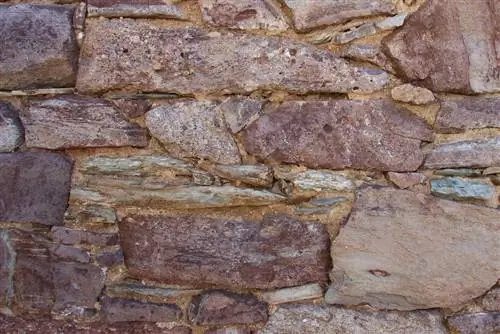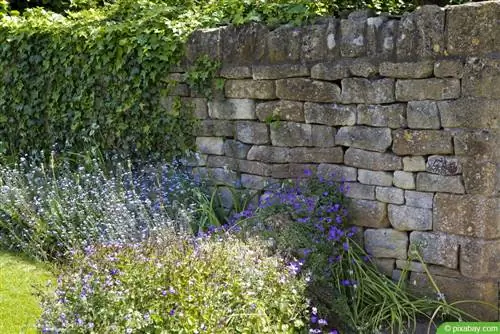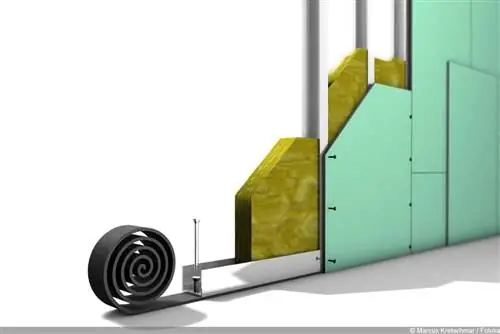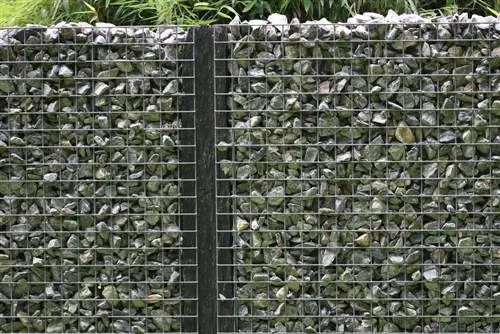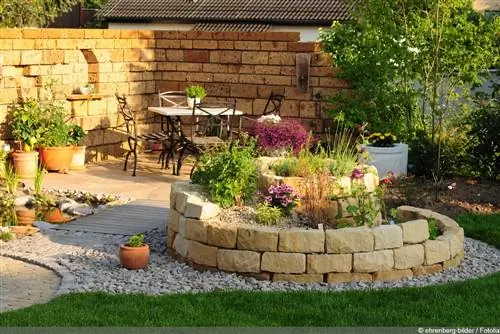- Author admin [email protected].
- Public 2023-12-17 03:39.
- Last modified 2025-01-24 12:45.
If you decide to have a retaining wall on your property, you will have to expect different costs depending on the type of wall. The type of wall is also responsible for the effort required to build the garden wall. The amount of work, together with the material costs, enables a complete breakdown of the costs incurred for the wall in your garden.
Expenses for different retaining wall types
Retaining walls are a special form of garden wall that can be used to secure embankments and slopes and also to close the earth in new raised beds or terraces. Once the wall is up, the earth can no longer move and is therefore stationary. This, for example, prevents the terrace from sinking, which would result in high repair costs. Retaining walls are necessary for this reason and, depending on the type, can even have a decorative character. However, building retaining walls requires effort that varies from wall type to wall type. The following list gives you an overview of the respective
Drywall
A dry wall completely dispenses with mortar and other binding agents that require moisture for use. The classic dry stone wall in the garden is made possible by stacking stones that are compacted with earth and create a particularly natural look. The construction is easy but time-consuming because the individual stones have to be placed by hand. Due to the low effort required, the walls are not suitable for steep or particularly long slopes as they would not be able to withstand the load. All you need for this project is a gravel foundation and enough time. The stones are natural stones.
Schalsteinmauer
Stone walls are easy to build down to the base and can be adapted to individual tastes if the appropriate plants are chosen. With this type of wall, the alignment is first determined with the help of a wall cord, then the first layer of mortar is applied to the concrete foundation and the foundation stones are laid. The reinforcing bars are then inserted into these. The mortar then has to dry and the further formwork blocks follow, which are connected using a simple plug-in system with tongue and grooves. From a height of 50 cm, the wall is filled with concrete and is therefore stable. The effort required to build a formwork stone wall is low and can be done by yourself.
Gabion Wall
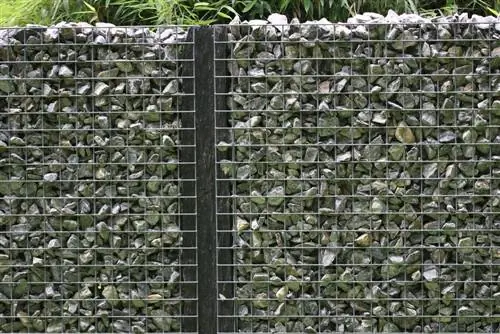
Gabion walls use the same system as gabion fences. The cages are attached to a concrete foundation and filled with stones. Since this is a wall made of gabions, the cages are usually very heavy and can only be placed using machines, especially if you want a high and long wall. The effort is also measured by whether you place the stones precisely in the cage or simply fill in a load of gabion stones. The first variant is extremely time-consuming and requires a close eye, while the second variant only requires an excavator and one person to control the device. Accordingly, the effort is determined by which gabion cages you choose.
Concrete wall
A classic concrete wall may not look particularly appealing, but it is extremely sturdy and will last for decades. Building a concrete wall involves a lot of effort and requires the most work of all wall types. It is recommended that this work be carried out by a company, as this requires heavy equipment and a lot of experience and planning on the part of the specialist, especially if the wall is larger in size. You can even pour small walls yourself, but this costs even more and takes a lot of time. The amount of work is also based on the accessibility of the construction site. The easier it is for the devices to get to the wall, the less effort it takes and vice versa.
Wall made of plant rings
Plant rings are very easy to set by yourself. They offer the opportunity to be planted, which makes them popular with many people as a retaining wall in the garden. They are set in the same way as the shell stones and require the same amount of work, but when setting, you have to pay even more attention to the correct position of the individual stones.
L-stones
L-stones are already cast concrete wall parts that are attached to a foundation and are particularly suitable for low walls in the garden. Since L-stones cannot be placed on top of each other, you must order L-stones of the appropriate size. This proves to be particularly difficult with high wall projects, as with every centimeter of height and width the stone becomes more difficult to transport using muscle power. For high walls, you will need an excavator to help you place the stones, as you cannot carry them even with another person. Nevertheless, the effort involved in setting is quite low and only requires precise measurements so that the stones are not crooked.
Foundation
Important for all types of walls is the foundation, which forms the basis of the wall. Only with a foundation can the wall stand straight and solid and not only shift the pressure of the earth that will be on the wall over a long period of time. This also ensures that the garden wall stands up effectively against the weather and does not collapse even under high loads from people, animals or heavy plants. Foundations for retaining walls can be made from different materials, depending on the final height of the wall:
- Gravel is used for walls lower than 120 cm
- Concrete is used for walls that are higher than 120 cm
A foundation made of gravel is particularly simple and can easily be done by yourself. However, if you have a concrete foundation, you should contact a professional. The reason for this is not the pouring of the foundation, but the required drainage, which must be planned precisely so that too much moisture cannot accumulate. Depending on the weather, this must be up to 1.5 meters deep, for example in regions with very cold winters such as the Alps or the Ore Mountains.
In the rest of Germany, one meter, in most cases 20 to 40 cm, is sufficient as a foundation if the winters are particularly mild and the subsoil consists of dense sedimentary structures. A gravel foundation, on the other hand, requires little planning and can be created yourself in just a few steps. Only excavating the earth can prove difficult.
The higher the wall needs to be, the more important it is to plan well. For this reason, for particularly tall projects, you should definitely hire a professional to take care of the implementation so that your wall will stand securely and will not be damaged the next time it rains or over the winter.
Costs
The costs for a retaining wall vary greatly and depend on several factors:
- Wall type
- Length
- Height
- necessary equipment, including devices such as mini excavators
- Material costs for the foundation
- Access to the site where the wall will be built
- Delivery costs
- Assembly, if a specialist company implements the project
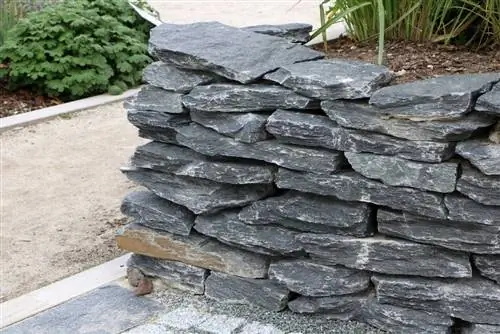
One of the most expensive elements when building a garden wall is the concrete foundation. For this, the costs are calculated in cubic meters. On average, you will have to spend 80 to 120 euros for one cubic meter of material. There are also costs for frost protection, sand and gravel that lie under the concrete layer. Now, if you have a wall that is 5 meters long, 30 centimeters wide and 1.50 meters high, a foundation that is 40 centimeters deep is required. Half of these 40 centimeters represents the concrete foundation. This gives you dimensions for the foundation of:
5 m length x 0.30 m width x 0.20 m height
This results in a filling volume of 0.3 cubic meters, which comes to a price of around 30 to 40 euros just for the material. Here, tools, hourly wages for workers and other utensils are not included in the price. On average, even for a small wall you have to expect foundation costs of 400 to 600 euros, which is mainly due to the equipment required and the dimensions of the foundation. The thicker the foundation has to be, the higher the costs will be. The cost of the wall itself depends on the type:
- Natural stones: 10 to 20 euros per stone
- Gabion stones: 100 to 500 euros per ton, depending on the type of stone
- Gabion baskets: 150 to 200 euros per cubic meter
- Concrete: 80 to 120 euros per cubic meter
- Scarf stones: 0.50 to 1.20 euros per scarf stone, depending on the dimensions
- L-stones: 5 to 20 euros per stone and upwards, depending on the dimensions
- reinforced L-stones: 30 to 80 euros per stone and upwards, depending on the dimensions
- Plant rings: from 1 euro per stone, prices vary greatly in terms of material, dimensions and can rise to over 50 euros
You see, depending on the dimensions, some wall types are better suited for shorter or longer walls. For concrete and L-stone walls, formwork is also necessary, which for the above-mentioned wall of 5 meters long x 0.30 meters wide x 1.50 meters high can cost between 400 and 600 euros. If reinforcement is needed, the costs are between 100 and 150 euros. Finally, there are the costs for construction equipment such as mini excavators, vibrating plates, concrete mixers and numerous other utensils, which are different for each type of wall. On average, concrete walls have the highest costs because a lot of material is required, but a dry stone wall can also be expensive due to the amount of stones required. Costs for delivery and construction of the wall vary greatly from region to region.
Tip:
Once you have decided on a type of wall, you should compare the offers from various providers in your area if you want to have it built by a specialist company. This step can save you potential costs, even if it is a large project that requires a lot of effort.

